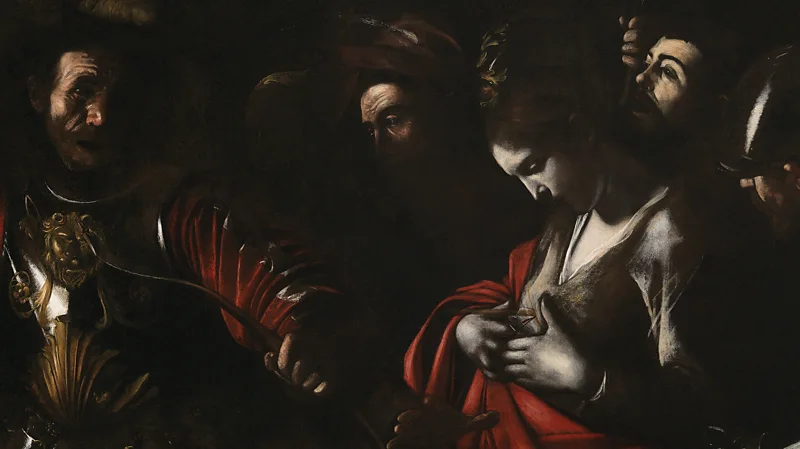The Martyrdom of Saint Ursula: How Caravaggio's violent 17th Century paintings led to Goodfellas and Mean Streets
As the record crowds flocking to see his last painting show, Caravaggio's violent life and the cinematic intensity of his work have proved to be irresistible for centuries.

Caravaggio's last painting, The Martyrdom of Saint Ursula, is a neat distillation of everything that made the Italian artist such a unique, and enduringly fascinating figure, perhaps the most influential artist who ever lived. There is the characteristic close cropping and dramatic lighting, so often referred to as "cinematic", as well as his revolutionary use of real figures for models, complete with grainy, weather-beaten skin and dirty fingernails.
There is also the artist himself, who appears as a horrified onlooker to Saint Ursula's murder. Caravaggio would frequently represent himself in his paintings, and his violent, brutal life and death have often fascinated audiences as much as his work, a fact borne out most recently by the artist's appearance as a source of inspiration to the nefarious anti-hero Tom Ripley in the recent Netflix series. That guest spot has perhaps played a part in the record crowds that this painting has attracted at The National Gallery in London, where it is currently on show as part of their 200th anniversary celebrations. And now a newly authenticated painting by the artist is going on show at the Prado museum in Madrid.
The drama of Caravaggio's last years can be seen to play out in both the form and content of the work. Tellingly, there is a roughness in the handling of the paint, a result of the horrific attack he had recently been subjected to in which his face had been slashed, and his sight perhaps affected. The identity of the assailants remains unknown, but they were likely connected to a knight Caravaggio had attacked while in Malta. He had sought refuge on the island, hoping to join the venerable order of Knights of St John in order to escape punishment for the murder of Ranuccio Tomassoni, a crime for which he was then on the run. The attack on Malta saw him flee once more, this time to Naples. But it seems he was still hoping for a Papal pardon, and in an optimistic moment had let his guard down on the evening of the assault.
Caravaggio makes his Martyrdom of Saint Ursula "very intimate, very brutal, very personal in a way that most other artists didn't at the time," curator Francesca Whitlum-Cooper tells the BBC. Rather than focussing on the favoured motif of Ursula's 11,000 virgin followers who were slaughtered by the Huns, Caravaggio homes in on the moment when Ursula herself has been shot by the King of the Huns for refusing his hand in marriage. Still alive, she gazes down at the arrow protruding from her body, her hands poignantly framing the agent of her martyrdom.
Whitlum-Cooper notes the astonishing psychological complexity and intensity of the characters, which for her adds to the cinematic quality of the work. "The King of the Huns manages to look both furious and regretful at the same time. The bystanders look horrified, but also as if they need to be towing the line, because they're his soldiers. Ursula looks peaceful but also shocked and surprised. Everyone has this multiplicity of emotions," she says.
However, when it comes to Caravaggio's self-portrait, the emotions are trickier to read. Whitlum-Cooper is fascinated by the fact that his attention does not appear to be on the action unfolding in front of him. "It's as if he's looking beyond the painting because he knows that he's just about to get pardoned, as if he's looking to Rome already."
"He's critically wounded in the autumn of 1609, hugely facially disfigured, but critically here he's not. He doesn't show us that mark of dishonour," she says. "There are a lot of questions around what he's doing with that self-portrait. Is he almost trying to paint himself back into the picture, literally and metaphorically? Is he culpable? He hasn't fired the arrow but he hasn't done anything to stop it. There's a lot of psychology to unpack."
'A complex character'
Caravaggio had always been a complex character, precociously gifted, but with a desire to provoke and a talent for self-destruction. He came of age in Milan at a time when the spirit of the Counter-Reformation was in full swing. "This is a moment in which the Catholic Church is saying that painting is there to make people feel things. It has to be powerful and elicit an emotional response in the devout," explains Whitlum-Cooper.
For Caravaggio this meant pursuing a very earthy, direct realism that was ground-breaking. "For centuries, it was the artist's role to classicise and make the world around them more beautiful, especially when telling Biblical stories. Then suddenly you have someone who famously gets a celebrated local prostitute to model as the Virgin Mary, and people from the streets to model as saints," she says.
For the general population who simply weren't used to seeing people like themselves on canvas, the effect was "enormously powerful", says Whitlum-Cooper, who likens it to issues around representation today. "We're used to seeing people of all strata represented but that wasn't really the case before.
"From the moment his work was first seen in public, his fame and influence began to spread. We have 17th-Century biographies of Caravaggio that talk about all the young artists flocking to look at these paintings," says Whitlum-Cooper.
A whole generation of artists in Rome were directly influenced by him, while subsequent generations travelled to the city to see his work. The political situation at the time, with Spain governing Naples, another city in which he was active, also helped spread his influence. Artemisia Gentileschi put a feminist spin on his style in her early works, while Rubens helped bring his approach to the Netherlands where a whole school of Northern Caravaggisti sprang up. The dramatic chiaroscuro of the Spanish painters Ribera and Zurbarán would have been unthinkable without him.
After his death a classicising faction of critics tried to denigrate Caravaggio's visceral style, with limited success. "French artists were told for centuries to keep away from Caravaggio," Andrew Graham-Dixon, Caravaggio's biographer, tells the BBC, but that had little effect. "Jacques Louis David, [Jean-Auguste-Dominique] Ingres – all of them are hypnotised by Caravaggio. They're told they shouldn't be, but they are."
When Scorsese was shooting Mean Streets, he said he and Paul Schrader would go more or less every day to the Met to look at the Caravaggios – Andrew Graham-Dixon
"The art is so fantastic that its influence goes all the way through to Picasso. People say Caravaggio fell out of favour during the modernist period but when Picasso was painting Guernica, Salvador Dalí went into the studio and Picasso said to him that he wished he could paint a horse like Caravaggio's in the Conversion of Saint Paul. He said he wanted a horse you could smell," Graham-Dixon says.
'Phenomenal global popularity'
While Caravaggio's influence among artists hardly seems to have waned, his phenomenal global public popularity took a little longer to take off. "It's hard to pinpoint exactly when he became so famous, but I don't think it's a coincidence that it picks up in the second half of the 20th Century when film and photography are becoming so much more widespread. Our cult of celebrity as well," says Whitlum-Cooper.
Caravaggio's impact on film is particularly notable in the work of Pier Paolo Pasolini and Martin Scorsese, who were inspired both by his dramatic lighting and his use of real, un-idealised people in his paintings. "Pasolini and the whole of Italian cinema comes through Caravaggio. There's a resurgence in Italy of a very spiritualised form of left-wing creativity which happens to take the form of cinema," says Graham-Dixon. For The Last Temptation of Christ, Scorsese said "the idea was to do Jesus like Caravaggio," but the artist's influence on him goes back to the 1970s.
"When Scorsese was shooting Mean Streets, he said he and Paul Schrader would go more or less every day to the Met to look at the Caravaggios," Graham-Dixon says. "They were thinking about framing. In Mean Streets the camera is always moving but Scorsese said to me that he feels that Caravaggio's camera was always moving, it was just trapped in a particular moment by the canvas."
Caravaggio's narrative approach – his tendency to portray the middle of an event rather than the beginning or the end of a scene – has also influenced Scorsese, in sometimes graphic ways. The Crucifixion of Saint Peter, in which the cross Peter is nailed to is being hauled into place was the inspiration for the scene in Goodfellas where Jimmy and Tommy have such difficulty killing Billy Batts. "All of that came from Peter – how hard it is to kill someone,” explains Graham-Dixon.
Violence and Caravaggio have always seemed to go hand in hand. Ripley writer and director, Steven Zaillian, has said that it was the parallels between the artist and Tom Ripley – two men who murdered someone in Rome and then had to go on the run – that interested him.
This is an association that troubles Whitlum-Cooper, who feels we should acknowledge how problematic his violence was, "even by the standard of violent times. He's the 'bad boy of the Baroque', but we don't talk about violent women like that, we don't talk about violent black men like that. It's really interesting what whiteness and genius permits," she says.
But it is worth remembering that Caravaggio, unlike Ripley, paid a high price for his crimes. Still suffering from his wounds, it seems he died shortly after completing his last painting while trying, and failing, to make it back to Rome.
Perhaps in the end we should focus more on the artistic highs than the violent lows. As Whitlum-Cooper concludes, "there are very few figures in the history of art where you can say: 'this artist changed the course of painting'. Just one person doing one thing, as opposed to a movement. I think he is one of those artists."
-bbc







